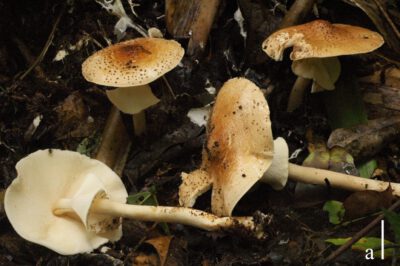Fungalpedia – Note 151 Echinoderma
Echinoderma (Locq. ex Bon) Bon
Citation if using this entry: Sysouphanthong et al. (in prep) – Fungalpedia Basidiomycota 3. Mycosphere.
Index Fungorum, Facesoffungi, MycoBank, GenBank, Figs 1–2
Classification: Fungi, Basidiomycota, Agaricomycotina, Agaricomycetes, Agaricales, Agaricaceae.
Bon (1981) placed Echinoderma in Cystolepiota Singer, and there were two subgenera which were C. subgen. Cystolepiota singer and C. subgen. Echinoderma Locq. ex Bon. Later, Echinoderma was separated to be independent genus by Bon (1991), two sections were included [sects. Echinoderma (Locq. ex Bon) Bon and Eriophora Bon], and Lepiota aspera (Pers.) Quél. [= Echinoderma asperum (Pers.) Bon] was the type species of sect. Echinoderma while Lepiota eriophora Peck [= Cystolepiota eriophora (Peck) Knudsen] was the type species of sect. Eriophora.
Species in Echinoderma are saprotrophic and terrestrial on soil, and characterized by lepiotoid basidiomata, covered with squamulose or pyramidal scales on pileus and erected with hymenodermal structure, dextrinoid basidiospores, and presence of clamp connections (Candusso and Lanzoni 1990, Bon 1991). Two shapes of basidiospores are present in the genus; large basidiospores with a triangle shape are present in the type species (Echinoderma asperum (Pers.) Bon and other species e.g. E. flavidoasperum Y.J. Hou & Z.W. Ge, E. hystrix (F.H. Møller & J.E. Lange) Bon and E. perplexum (Knudsen) Bon; and small basidiospores with ovoid to amydaliform shape are present in E. carinii (Bres.) Bon, E. echinaceum (J.E. Lange) Bon, E. jacobi (Vellinga & Knudsen) Gminder and E. pseudoasperulum (Knudsen) Bon (Candusso and Lanzoni 1990, Bon 1991, Hou and Ge 2020).
Echinoderma species was placed in Lepiota sect. Echinatae Fayod in some studies (Vellinga 2003, Liang 2007, Sysouphanthong et al. 2011, Razaq et al. 2013). Vellinga (2003) included Echinoderma (= Lepiota sect. Echinatae) in molecular analysis of Lepiota based on ITS and LSU genes, it was found that Lepiota was not a monophyletic genus, species of L. sect. Echinatae were separated into two clades, species with small basidiospores were in Lepiota clade, and species with large basidiospores clustered with Coprinus, Cystolepiota and Melanophyllum. Furthermore, the multi-locus sequence analysis (combined ITS, 28S, rpb2, and tef1) indicated that species with small basidiospores belong in the lepiota clade (=Lepiota sect. Echinatae), and species with large basidiospores clustered in an independent clade (Hou and Ge 2020, Ge et al. 2021, Sysouphanthong et al. 2022, Qu et al. 2023).
Synonymy: Cystolepiota subgen. Echinoderma Locq. ex Bon
Type species: Echinoderma asperum (Pers.) Bon
Other accepted species:
Echinoderma asperum (Pers.) Bon
Echinoderma badiopurpureum (Papetti) Papetti
Echinoderma boertmannii (Knudsen) Bon
Echinoderma bonii C.E. Hermos. & Jul. Sánchez
Echinoderma calcicola (Knudsen) Bon 1991
Echinoderma carinii (Bres.) Bon
Echinoderma echinaceum (J.E. Lange) Bon
Echinoderma efibulis (Knudsen) Bon
Echinoderma flavidoasperum Y.J. Hou & Z.W. Ge
Echinoderma friulianum (Zecchin & Bizzi) Zecchin & Bizzi
Echinoderma hystrix (F.H. Møller & J.E. Lange) Bon
Echinoderma jacobi (Vellinga & Knudsen) Gminder
Echinoderma perplexum (Knudsen) Bon
Echinoderma pseudoasperulum (Knudsen)
Echinoderma rubellum (Bres.) Migl.
Figure 1. Echinoderma asperum (= Lepiota aspera, MFLU 09-0181) in situ. Scale bars: a= 20 mm. Photos from Sysouphanthong et al. (2011).
Figure 2. Echinoderma asperum (= Lepiota aspera). a basidiomata and a section. b basidiospores. c cheilocystidia d pileus covering. Scale bars: a = 20 mm, b = 5 µm, c = 10 µm, d = 20 µm. Line drawing from herbarium of MFLU 09-0181 in Sysouphanthong et al. (2011, 2013).
References
Liang JF 2007 – Lepiota jacobi, a species new to east Asia. Acta Botanica Yunnanica 29 (6), 617–618.
Razaq A, Khalid AN, Ilyas S 2013 – Molecular Identification of Lepiota acutesquamosa and L. cristata (Basidiomycota, Agaricales) Based on ITS-rDNA Barcoding from Himalayan Moist Temperate Forests of Pakistan. International Journal of Agriculture & Biology 15 (2), 313–318.
Sysouphanthong P, Hyde KD, Chukeatirote E, Vellinga EC 2011 – A review of genus Lepiota and its distribution in east Asia. Current Research in Environmental & Applied Mycology 1(2), 161–176.
Sysouphanthong P Hyde KD, Vellinga EC, Chukeatirote E. 2013 – Diversity of Lepiota (Agaricales) in northern Thailand. Mycology 4, 22–28.
Vellinga EC 2003 – Phylogeny of Lepiota (Agaricaceae)—evidence from nrITS and nrLSU sequences. Mycological Progress 2 (4), 305–322.
Entry by
Phongeun Sysouphanthong, Center of Excellence in Fungal Research, Mae Fah Luang University, Chiang Rai 57100, Thailand
Edited by Kevin D Hyde
Published online 9 October 2023

